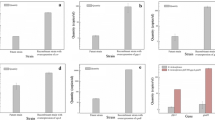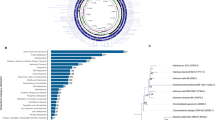Abstract
Bioflocculants are special high-molecular weight polymers produced by microorganisms. Despite the fact that several types of bioflocculants from different species of bacteria have been reported, there is a large gap in our knowledge regarding the molecular machine responsible for the production of bioflocculants. To investigate genes involved in bioflocculant synthesis, a fosmid library was generated from Bacillus licheniformis genomic DNA and screened for the production of bioflocculant. Four positive clones with distinct flocculation were isolated by a two-pooling scheme. The clone with 662 U ml−1 flocculating activity was sequenced. As a result, a 30-kb fragment with 26 hypothetical genes was identified in the bioflocculant-producing clone. Most of the predicted proteins encoded by the inserted genes showed significant homology with enzymes involved in the biosynthesis of polysaccharide. Based on these homologies, a biosynthesis pathway and two gene clusters involved in the production of the polysaccharide bioflocculant were proposed with the integration of functional descriptions of individual genes by metabolic databases, and a glucose-sensitive glycosidases was predicted. This research supplied significant data for potential application of bioflocculant-producing strains in wastewater refining and industrial downstream treatments.






Similar content being viewed by others
References
Abranches J, Chen YY, Burne RA (2004) Galactose metabolism by Streptococcus mutans. Appl Environ Microbiol 70(10):6047–6052
Allard ST, Giraud MF, Naismith JH (2001) Epimerases structure, function and mechanism. Cell Mol Life Sci 58:1650–1665
Allen MS, Welch KT, Prebyl BS, Baker DC, Meyers AJ, Sayler GS (2004) Analysis and glycosyl composition of the exopolysaccharide isolated from the floc-forming wastewater bacterium Thauera sp. MZ1T. Environ Microbiol 6(8):780–790
Anna Skorupska MJ, Małgorzata M, Andrzej M, Jaroslaw K (2006) Rhizobial exopolysaccharides: genetic control and symbiotic functions. Micro Cell Fact 5(1):7–25
Bauer FF, Govender P, Bester MC (2010) Yeast flocculation and its biotechnological relevance. Appl Microbiol Biotechnol 88(1):31–39
Birgit V, Christina H, Silke S, Jörg Feesche KHM, Petra E, Sebastian B, Anke H, Heiko L, Rainer M, Armin E, Gerhard G (2004) The complete genome sequence of Bacillus licheniformis DSM13, an organism with great industrial potential. J Mol Microb Biotech 7(4):204–211
Cosa S, Mabinya LV, Olaniran AO, Okoh OO, Bernard K, Deyzel S, Okoh AI (2011) Bioflocculant production by Virgibacillus sp. Rob isolated from the bottom sediment of Algoa Bay in the Eastern Cape, South Africa. Molecules 16(3):2431–2442
Cuthbertson L, Kimber MS, Whitfield C (2007) Substrate binding by a bacterial ABC transporter involved in polysaccharide export. Proc Natl Acad Sci U S A 104(49):19529–19534
Donot F, Fontana A, Baccou JC, Schorr-Galindo S (2012) Microbial exopolysaccharides: main examples of synthesis, excretion, genetics and extraction. Carbohydr Polym 87(2):951–962
Erlich Y, Chang K, Gordon A, Ronen R, Navon O, Rooks M, Hannon GJ (2009) DNA Sudoku-harnessing high-throughput sequencing for multiplexed specimen analysis. Genome Res 19(7):1243–1253
Erni B (2012) The bacterial phosphoenolpyruvate: sugar phosphotransferase system (PTS): an interface between energy and signal transduction. J Iran Cheml Soc 10(3):593–630
Fazli M, McCarthy Y, Givskov M, Ryan RP, Tolker-Nielsen T (2013) The exopolysaccharide gene cluster Bcam1330-Bcam1341 is involved in Burkholderia cenocepacia biofilm formation, and its expression is regulated by c-di-GMP and Bcam1349. MicrobiologyOpen 2(1):105–122
Glucksmann MA, Reuber TL, Walker GC (1993) Family of glycosyl transferases needed for the synthesis of succinoglycan by Rhizobium meliloti. J Bacteriol 175(21):7033–7044
Hansen SF, Bettler E, Rinnan A, Engelsen SB, Breton C (2010) Exploring genomes for glycosyltransferases. Mol Biosyst 6(10):1773–1781
Hay ID, Ur Rehman Z, Ghafoor A, Rehm BHA (2010) Bacterial biosynthesis of alginates. J ChemTech Biotech 85(6):752–759
Kearns DB, Chu F, Branda SS, Kolter R, Losick R (2005) A master regulator for biofilm formation by Bacillus subtilis. Mol Microbiol 55(3):739–749
Kolkman MA, Morrison DA, Van Der Zeijst BA, Nuijten PJ (1996) The capsule polysaccharide synthesis locus of streptococcus pneumoniae serotype 14: identification of the glycosyl transferase gene cps14E. J Bacteriol 178(13):3736–3741
Kumar AS, Mody K, Jha B (2007) Bacterial exopolysaccharides—a perception. J Basic Microbiol 47(2):103–1017
Kurane R, Hatamochik K, Kakuno T, Kiyohara M, Kawaguchi K, Mizuno Y, Hirano M, Taniguchi Y (1994) Purification and characterization of lipid bioflocculant produced by Rhodococcus erythropolis. Biosci Biotechl Bioch 58(11):1977–1982
Laws A, Gu Y, Marshall V (2001) Biosynthesis, characterisation, and design of bacterial exopolysaccharides from lactic acid bacteria. Biotechnol Adv 19(8):597–625
Leivers S, Hidalgo-Cantabrana C, Robinson G, Margolles A, Ruas-Madiedo P, Laws AP (2011) Structure of the high molecular weight exopolysaccharide produced by Bifidobacterium animalis subsp. lactis IPLA-R1 and sequence analysis of its putative eps cluster. Carbohydr Res 346(17):2710–2717
Maeda Y, Kinoshita T (2008) Dolichol-phosphate mannose synthase: structure, function and regulation. Biochim Biophys Acta 1780(6):861–868
Marvasi M, Visscher PT, Casillas Martinez L (2010) Exopolymeric substances (EPS) from Bacillus subtilis: polymers and genes encoding their synthesis. FEMS microbiol Lett 313(1):1–9
Matilla MA, Travieso ML, Ramos JL, Ramos-Gonzalez MI (2011) Cyclic diguanylate turnover mediated by the sole GGDEF/EAL response regulator in Pseudomonas putida: its role in the rhizosphere and an analysis of its target processes. Environ Microbiol 13(7):1745–1766
Meng G, Fütterer K (2003) Structural framework of fructosyl transfer in Bacillus subtilis levansucrase. Nat Struct Mol Biol 10(11):935–941
Park C, Novak JT (2009) Characterization of lectins and bacterial adhesins in activated sludge flocs. Water Environ Res 81(8):755–764
Petit AC (2005) Modifications d'un exopolysaccharide biosynthétisé par une bactérie issue des écosystèmes Hydrothermaux profonds. Dissertation. Université de Rennes
Ramage G, Mowat E, Jones B, Williams C, Lopez-Ribot J (2009) Our current understanding of fungal biofilms. Crit Rev Microbiol 35(4):340–355
Reeves PR, Hobbs M, Valvano MA, Skurnik M, Whitfield C, Coplin D, Kido N, Klena J, Maskell D, Raetz CRH, Rick PD (1996) Bacterial polysaccharide synthesis and gene nomenclature. Trends Biotechnol 4(12):495–503
Rosalam S, England R (2006) Review of xanthan gum production from unmodified starches by Xanthomonas comprestris sp. Enzyme Microb Tech 39(2):197–207
Salehizadeh H, Shojaosadati SA (2002) Isolation and characterisation of a bioflocculant produced by Bacillus firmus. Biotechnol Lett 24:35–40
Salehizadeh H, Vossoughi M, Alemzadeh I (2000) Some investigations on bioflocculant producing bacteria. Biochem Eng J 5:39–44
Sheng GP, Yu HQ, Li XY (2010) Extracellular polymeric substances (EPS) of microbial aggregates in biological wastewater treatment systems: a review. Biotechnol Adv 28(6):882–894
Shih IL, Van YT, Yeh LC, Lin HG, Chang YN (2001) Production of a biopolymer flocculant from Bacillus licheniformis and its flocculation properties. Bioresour Technol 78:267–372
Subramanian SB, Yan S, Tyagi RD, Surampalli RY, Lohani BN (2008) Isolation and molecular identification of extracellular polymeric substances (EPS) producing bacterial strains for sludge settling and dewatering. J Environ Sci Heal 43(13):1495–1503
Tao F, Swarup S, Zhang LH (2010) Quorum sensing modulation of a putative glycosyltransferase gene cluster essential for Xanthomonas campestris biofilm formation. Environ Microbiol 12(12):3159–3170
Tokuda G, Miyagi M, Makiya H, Watanabe H, Arakawa G (2009) Digestive beta-glucosidases from the wood-feeding higher termite, Nasutitermes takasagoensis: intestinal distribution, molecular characterization, and alteration in sites of expression. Insect Biochem Mol Biol 39(12):931–937
Vorhölter F-J, Schneiker S, Goesmann A, Krause L, Bekel T, Kaiser O, Linke B, Patschkowski T, Rückert C, Schmid J (2008) The genome of Xanthomonas campestris sp. campestris B100 and its use for the reconstruction of metabolic pathways involved in xanthan biosynthesis. J Biotech 134(1):33–45
Wenyu L, Tong Z, Dongyan Z, Caihong L, Jianping W, Lianxiang D (2005) A novel bioflocculant produced by Enterobacter aerogenes and its use in defecating the trona suspension. Biochem Eng J 27(1):1–7
Xiaoling Z, Yuanpeng W, Qingbiao L, Shan Y, Ning H (2012) The production of bioflocculants by Bacillus licheniformis using molasses and its application in the sugarcane industry. Biotechnol Bioproc E 17(5):1041–1047
Yokoi H, Natsuda O, Hirose J, Hayashi S, Takasak Y (1995) Characteristics of a biopolymer flocculant produced by Bacillus sp. PY-90. J Biosci Bioeng 79(4):378–380
Yuyan X, Yuanpeng W, Yi Y, Qingbiao L, Haitao W, Ronghui C, Ning H (2010) Production and characterization of a novel bioflocculant from Bacillus licheniformis. Appl Environ Microbiol 76(9):2778–2782
Zeng L, Das S, Burne RA (2010) Utilization of lactose and galactose by Streptococcus mutans: transport, toxicity, and carbon catabolite repression. J Bacteriol 192(9):2434–2444
Zeng L, Xue P, Stanhope MJ, Burne RA (2013) A galactose-specific sugar: phosphotransferase permease is prevalent in the non-core genome of Streptococcus mutans. Mol Oral Microbiol 28(4):292–301
Zhu F, Wu R, Zhang H, Wu H (2013) Structural and biochemical analysis of a bacterial glycosyltransferase. Methods Mol Biol 1022:29–39
Acknowledgments
This work was financially supported by the National Basic Research Program of China (2013CB733505), Xiamen Science and Technology committee (3502Z20121021), National natural science foundation of China (51378444) and Shenzhen Science and Technology Research Project (JC201005280412A).
Author information
Authors and Affiliations
Corresponding authors
Electronic supplementary material
Below is the link to the electronic supplementary material.
ESM 1
(PDF 101 kb)
Rights and permissions
About this article
Cite this article
Yan, S., Wang, N., Chen, Z. et al. Genes encoding the production of extracellular polysaccharide bioflocculant are clustered on a 30-kb DNA segment in Bacillus licheniformis . Funct Integr Genomics 13, 425–434 (2013). https://doi.org/10.1007/s10142-013-0333-4
Received:
Revised:
Accepted:
Published:
Issue Date:
DOI: https://doi.org/10.1007/s10142-013-0333-4




